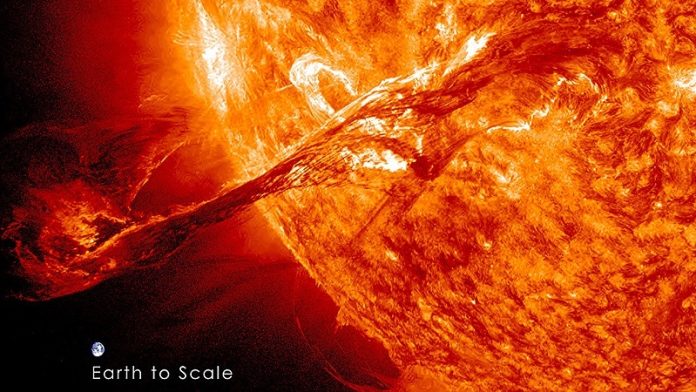
Earth is constantly bombarded by solar wind, a stream of charged particles from the sun.
This solar wind interacts with Earth’s magnetic field, creating a protective bubble called the magnetosphere.
Normally, this interaction forms a front called a bow shock on the sunward side and stretches the magnetosphere into a wind sock shape with a long tail on the nightside.
Dramatic changes in the solar wind can alter the magnetosphere’s structure and dynamics.
A recent example of such changes provides valuable insights into the behavior of other space bodies, such as Jupiter’s moons and distant planets.
In a study published in Geophysical Research Letters, Li-Jen Chen and colleagues describe an unprecedented phenomenon observed during a coronal mass ejection (CME).
CMEs are massive bursts of solar wind and magnetic fields rising above the solar corona or being released into space.
They typically travel faster than the Alfvén speed, which is the speed at which magnetic field lines move through magnetized plasma.
On April 24, 2023, NASA’s Magnetospheric Multiscale Mission (MMS) spacecraft observed a unique CME event. Usually, the solar wind travels faster than the Alfvén speed, but during this strong CME, the Alfvén speed was even faster than the solar wind.
This rare occurrence caused Earth’s bow shock to temporarily disappear, allowing the solar plasma and magnetic field to interact directly with the magnetosphere.
For about two hours, Earth’s magnetosphere was without its usual wind sock tail. Instead, structures called Alfvén wings formed, connecting Earth’s magnetosphere directly to the recently erupted region of the sun.
These Alfvén wings acted like highways, transporting plasma between the magnetosphere and the sun.
This unique CME event offered new insights into how Alfvén wings form and evolve. The researchers suggest that a similar process could occur around other magnetically active bodies in our solar system and beyond. For instance, the formation of aurorae on Jupiter’s moon Ganymede may also be attributed to Alfvén wings.
The study’s authors propose that future research could investigate similar Alfvén wing aurorae occurring on Earth. Understanding these phenomena better could help scientists learn more about the interactions between solar wind and magnetic fields in space.
The findings from this event provide a better understanding of space weather and its impact on Earth’s magnetosphere. They also offer clues about the behavior of other celestial bodies with magnetic fields, which can help in studying planets and moons both within our solar system and in distant star systems.
The observations made by the MMS spacecraft highlight the complex and dynamic nature of space environments and the ongoing need to study these interactions to protect our planet and enhance our knowledge of the universe.



